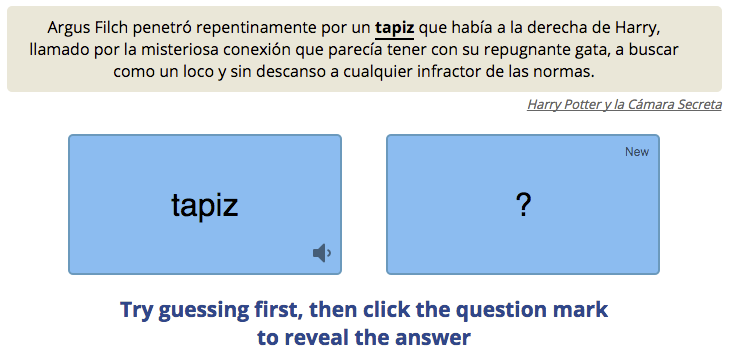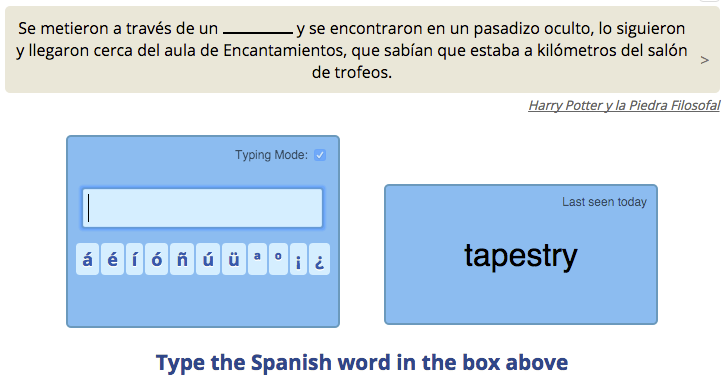The best way to read in the language you're learning
The Readlang Method for Learning Vocab
January 21, 2016I found vocabulary to be the most intimidating part of learning a foreign language. I’m an engineer at heart, more at home with math & physics, where you learn a small amount of things, from which everything else can be derived.
The other aspects of Spanish such as pronunciation and grammar seemed to offer a set of rules which could be learned, practiced and internalized given a reasonable amount of studying. (I particularly like Michel Thomas and Duolingo for this.) But I had no handle on how to learn vocabulary. I’ve never been a fan of rote learning, and hence never developed skills to learn vast quantities of unrelated things. It seems to take somewhere in the order of 10,000 words to read comfortably in a foreign language. It may as well have been infinite. How on earth do you approach learning 10,000 of anything?
Where to start
Word usage falls very rapidly from top ones like “the” to common ones like “house” and then to more esoteric ones like “esoteric” (see Zipf’s law). You’ll often hear statements like “the top 1000 words cover 80% of all texts”. This is motivating, but once you’ve learned the top 1000 words and realize how little you understand, you get jaded and realize that it’s those 20% of rarer words that carry the most meaning. But given you never know which rarer words you may need, it clearly makes sense to focus on learning the most frequent ones first.
We could download a list of the most frequent words with translations and start memorizing. But that would be a bad idea because:
- An isolated word often has no direct translation, and needs to be surrounded by other words to carry meaning.
- Your ultimate goal isn’t to know X words, it’s to be able to string them together to express ideas and thoughts in sentences and conversation.
- We remember things better when they form connections with other memories or concepts. You’ll remember words more effectively when they are used in an interesting or emotionally charged context.
- The top 1,000 words from one particular list may not be the ideal 1,000 words for you to learn. A backpacker will need a different set than a businessman.
- A list this long is too intimidating to memorize without a good strategy.
Luckily, there’s a solution… Read interesting content relevant to you. This appears to fix all these problems. You will encounter the most useful words more frequently, and they will be charged with interesting contexts and meaning. But reading is difficult without the necessary vocabulary. Catch 22.
How to read
Since reading seems like an effective way to improve vocabulary, but is too difficult, we should make it easier.
What makes reading difficult? Given enough time and a good dictionary, you can normally figure out the meaning of what you’re reading. The real difficulty comes from the slow-down and distraction that this causes.
When reading in your native language you can inhabit the world of the text and focus completely on the characters, descriptions and ideas within. If you start to think about anything else, it can break the spell. Your eyes continue scanning the words, but your mind is elsewhere. If this happens in your first language, imagine how easily it can in another language where you are always distracted by the need to decipher new words and phrases.
If you are more interested in reading purely as a language learning study method, this may not bother you too much. You can lose your way in the story and still pick up a lot of the language. But enjoying what you read is much better. Not only because you are likely to keep doing it longer, but because the ideas and characters and emotions of the story will form connections that help cement the new vocabulary in your memory. So it’s important that reading should be as fast and distraction free as possible so that you can actually enjoy it.
This is where technology comes to the rescue. All ebook readers have built in dictionaries these days. These are less distracting and hence preferable to paper dictionaries. But they often involve multiple clicks, button presses or short delays. This is because they aren’t built solely for language learners, and translations aren’t their main feature. If you want an e-reader designed for language learners, you should try Readlang, where one tap on a word, or one swipe across a phrase, offers an immediate translation. This is frictionless, and a great ally in the battle to stay focused on the story.

While you’re enjoying the story, some magic happens behind the scenes. Every translation is stored, along with its context, for you to drill later.
How to drill vocabulary
Some people don’t like flashcards or other rote drilling methods, and that’s fine, you can get by without them. But for people who want to give their vocabulary a boost with minimal study time, there’s a tool that many expert language learners swear by…
Spaced repetition is an effective way to memorize a large quantity of things, and is very suited for learning vocabulary. It’s a long term approach. But it aims to reduce the total time spent studying by scheduling repeat exposure to a word at longer and longer intervals.
I normally prefer more creative methods of practicing, but I’ve come to appreciate the ease and effectiveness of daily spaced repetition flashcards when it comes to vocabulary.
Here’s how a practice session with Readlang looks.
-
A small deck of the most frequently used words is pulled from your translation history.
-
You work through the small deck one by one. Each card starts in passive mode. You see the target language word within its context sentence, and you need to guess its meaning in your first language. If you guess correctly, it flips over to active mode. The card is then reinserted back into the deck so and will appear again shortly.

-
If the card has been flipped to active mode, you see the word’s context as a cloze sentence, plus the translation. You need to guess the original word or phrase. This is more difficult than passive mode. Once you do this successfully, you’ve finished that card for the day and it’s removed from the session deck. If you came close to remembering, the card is placed back in the deck in active mode. If you completely failed, the card is placed back in the deck in passive mode.

-
Once you’ve finished the deck, you are shown when each word is scheduled for studying next. Those words will not be shown in any practice sessions until that date, allowing you to learn different words in the meantime.
If you use this system daily, it will allow to learn a huge amount useful vocabulary in a systematic and engaging way.
Here are the key ways it optimizes your vocabulary learning:
- Focuses only on words and phrases that are relevant to you, since you encountered them while reading.
- Prioritizes the most useful words in the language based on word frequency lists.
- Schedules your learning with spaced repetition, repeating words you find the most difficult more often.
- Displays the context sentence to provide more meaning, jog your memory, and aid retention.
There are other flashcard apps available, and if you have another favorite, you can export words and their context sentences, using Readlang just for reading and collecting vocab. See this tutorial on exporting from Readlang to Anki.
TL;DR
Learning vocabulary is intimidating. The combination of reading, collecting new vocab, and reviewing with spaced repetition flashcards is a good approach.
Tweet comments powered by Disqus